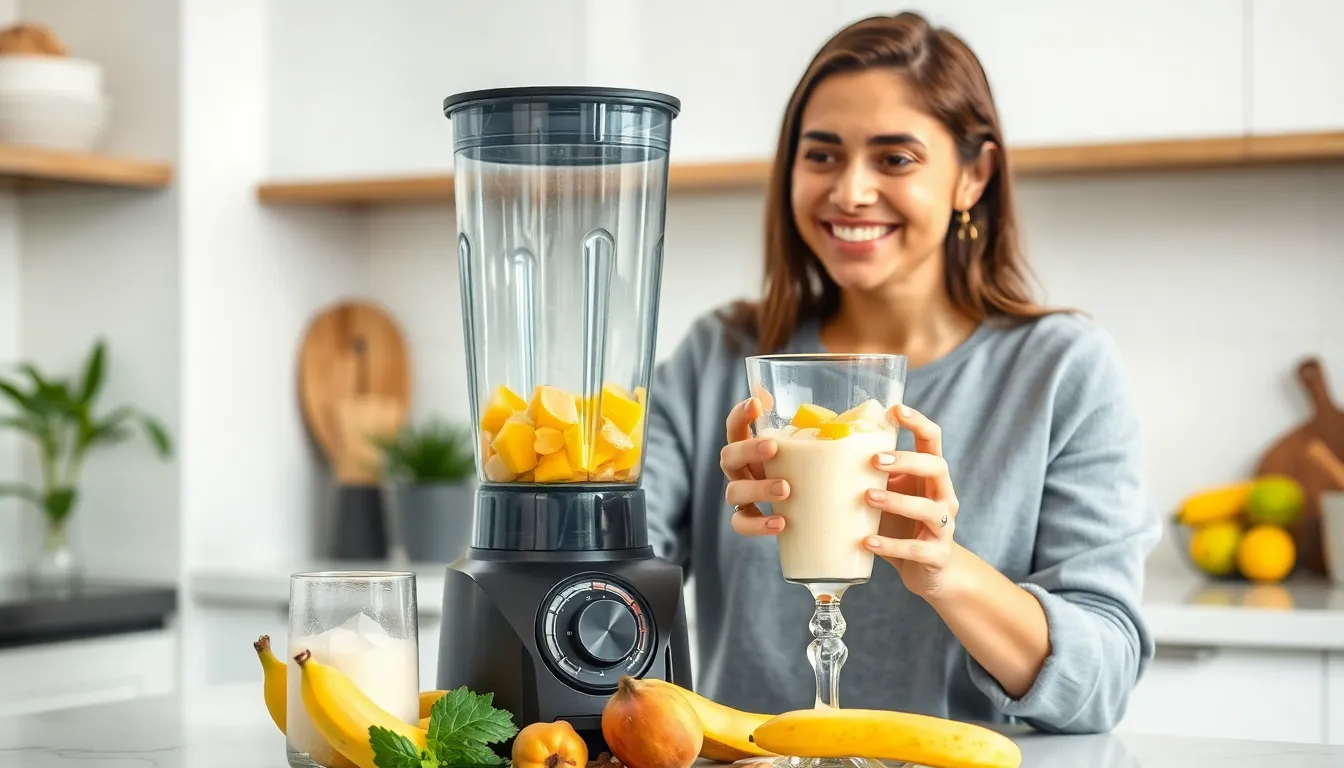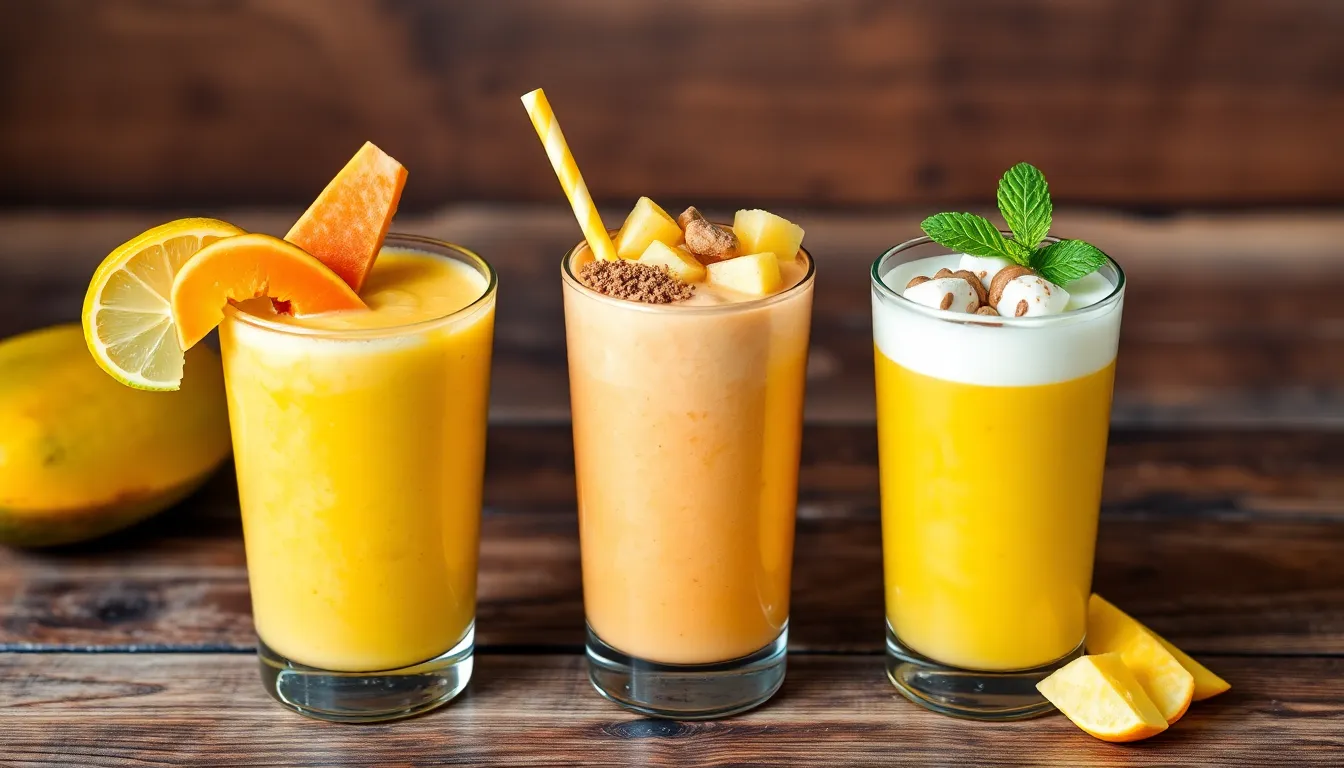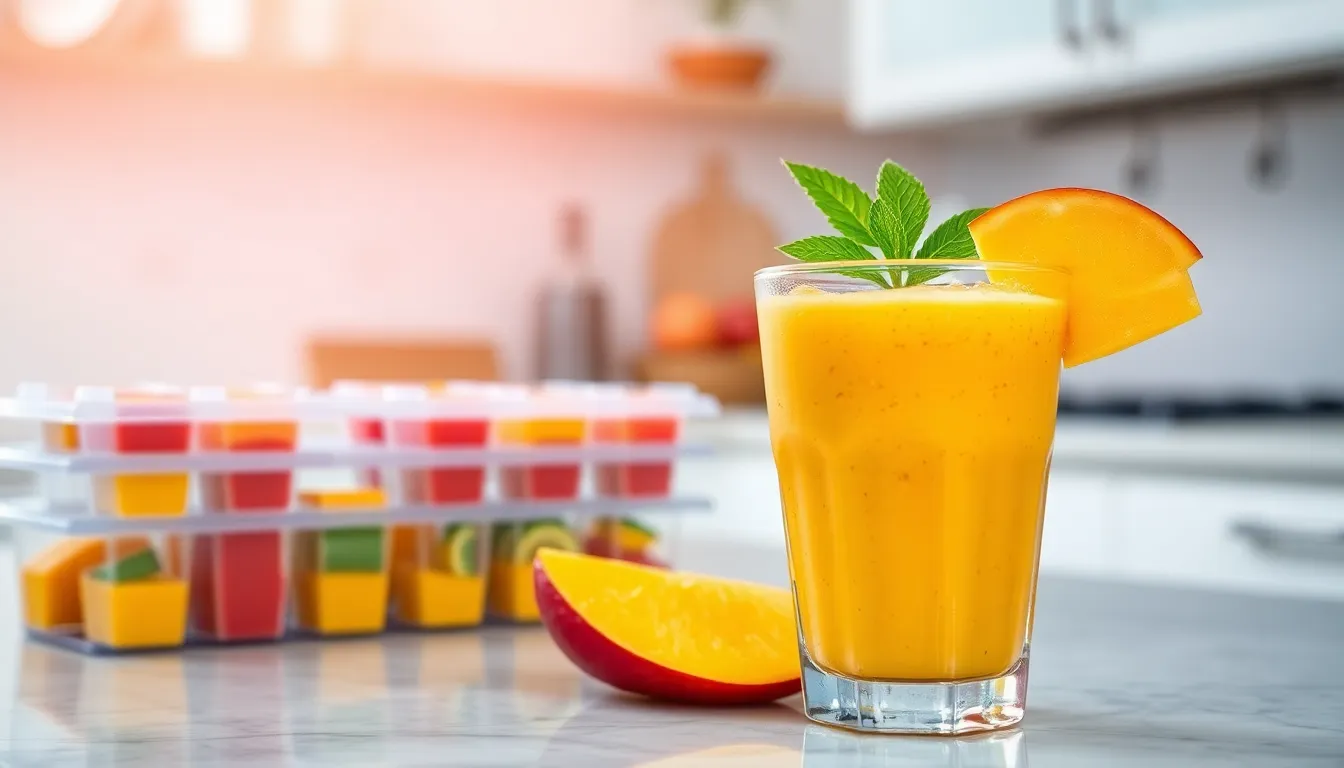Nothing beats the tropical sweetness of a perfectly ripe mango transformed into a creamy, dreamy smoothie. We’ve perfected this mango smoothie recipe that captures the essence of summer in every sip – whether you’re battling winter blues or celebrating peak mango season.
This vibrant golden drink isn’t just delicious; it’s packed with vitamin C, fiber, and antioxidants that’ll fuel your day. We love how versatile this recipe is – you can make it dairy-free with coconut milk, add protein powder for a post-workout boost, or blend in some spinach for extra nutrients without compromising that incredible mango flavor.
Ingredients
We’ll walk you through each component that makes our mango smoothie both nutritious and irresistibly delicious. These carefully selected ingredients work together to create the perfect balance of tropical flavor and creamy texture.
Fresh Mango
- 1 large ripe mango (about 1 cup diced) or 1 cup frozen mango chunks
- Alternative: 1 cup canned mango (drained)
We recommend using fresh mangoes when they’re in season for the best flavor and natural sweetness. Frozen mango chunks work perfectly and actually create a thicker consistency without needing ice. The fruit should yield slightly to gentle pressure when ripe.
Liquid Base Options
- 1/2 cup whole milk (dairy option)
- 1/2 cup coconut milk (creamy dairy-free option)
- 1/2 cup almond milk (light dairy-free option)
- 1/2 cup oat milk (neutral-tasting dairy-free option)
- 1/4 cup orange juice plus 1/4 cup water (citrus boost option)
We suggest starting with less liquid and adding more as needed to reach your desired consistency. Coconut milk provides the richest texture while almond milk keeps the smoothie lighter.
Sweetener Choices
- 1-2 tablespoons honey (natural option)
- 1-2 tablespoons maple syrup (vegan option)
- 2-3 pitted dates (whole food option)
- 1-2 teaspoons agave nectar (mild sweetness)
- 1 ripe banana (natural sweetness and creaminess)
We recommend tasting your mango first since very ripe mangoes often provide enough natural sweetness. Start with less sweetener and adjust according to your preference.
Optional Add-ins
- 1/2 cup vanilla Greek yogurt (protein and probiotics)
- 1 scoop vanilla protein powder (post-workout nutrition)
- 1 handful fresh spinach (hidden greens)
- 1 tablespoon chia seeds (omega-3 fatty acids)
- 1/2 teaspoon fresh ginger (digestive benefits)
- 1/4 teaspoon turmeric (anti-inflammatory properties)
- 1/2 cup ice cubes (if using fresh mango)
We love adding Greek yogurt for extra protein and a tangy flavor that complements the mango beautifully. Spinach blends seamlessly without affecting the tropical taste while boosting the nutritional value significantly.
Equipment Needed

Creating our perfect mango smoothie requires minimal equipment that most home cooks already have in their kitchen. We recommend gathering these essential tools before starting to ensure a smooth preparation process.
Blender serves as the cornerstone of our smoothie making process. Any model works effectively for this recipe, though high-powered blenders deliver superior consistency and texture. We find that powerful blenders create the silky smooth finish that makes our mango smoothie irresistible.
Measuring cups and spoons ensure accurate proportions for consistent results every time. We use these tools to measure our liquid ingredients precisely, particularly when balancing milk and yogurt ratios. Proper measurements guarantee the perfect texture and flavor balance we’re aiming for.
Additional helpful tools include a cutting board and sharp knife for fresh mango preparation. We also recommend having glasses ready for immediate serving since this smoothie tastes best when enjoyed fresh from the blender.
| Equipment | Purpose | Notes |
|---|---|---|
| Blender | Primary mixing tool | High-powered preferred for smoothest texture |
| Measuring cups | Accurate liquid measurement | Essential for consistent results |
| Measuring spoons | Precise small amounts | For optional honey or lime juice |
| Cutting board | Mango preparation | Only needed for fresh fruit |
| Sharp knife | Fruit slicing | For fresh mango prep |
Our equipment list remains simple and accessible, ensuring anyone can create this delicious smoothie without specialized tools. Most kitchens already contain everything needed to blend up this tropical treat.
Instructions

Creating our perfect mango smoothie follows a simple four-step process that delivers consistently delicious results. Let’s walk through each step to ensure we achieve that ideal creamy texture and tropical flavor.
Prep the Mango
We begin by selecting ripe mangoes that yield slightly to gentle pressure. Wash the mangoes thoroughly under cool running water before peeling away the skin with a sharp knife or vegetable peeler. Remove the pit by cutting around it and chop the flesh into chunks for easier blending.
Fresh mango chunks work beautifully, though we can also use frozen mango pieces for a thicker consistency. When using fresh mango, we recommend processing and freezing the chunks beforehand if we prefer an extra thick smoothie texture without adding ice.
Blend the Smoothie
We place our prepared mango chunks into the blender along with our chosen ingredients. Add 1-2 cups of mango chunks, ½-1 banana (fresh or frozen), and ½-1½ cups of liquid base such as milk, almond milk, or orange juice per serving.
Optional ingredients like Greek yogurt or honey can be added at this stage for extra creaminess or sweetness. We blend everything on high speed until the mixture becomes completely smooth and creamy. The typical ratio ensures we get the perfect balance of flavors while maintaining that signature mango taste.
Adjust Consistency and Taste
Our smoothie’s consistency should be creamy but pourable. If the mixture appears too thick, we add small amounts of liquid and blend again until we reach the desired consistency. When the smoothie seems too thin, we incorporate more mango chunks or a few ice cubes to achieve the perfect thickness.
We taste our creation and adjust the sweetness as needed by adding honey or our preferred sweetener. The natural sweetness of ripe mangoes often provides enough flavor, but we can enhance it based on our preference.
Serve Immediately
We pour our finished smoothie into chilled glasses and serve right away for the best texture and flavor experience. Smoothies naturally thicken when left out, so immediate consumption delivers the optimal taste and consistency we’ve worked to achieve.
For the best results, we ensure our blender jar is securely attached before operating at high speed. We clean the blender promptly after use to maintain easy maintenance and customize our ingredients according to dietary preferences or what we have available.
Recipe Variations

Our basic mango smoothie recipe serves as the perfect foundation for countless delicious variations. We love experimenting with different ingredients to create unique flavor profiles that cater to various dietary needs and taste preferences.
Tropical Mango Smoothie
We transform our classic recipe into a tropical paradise by adding complementary fruits that enhance the exotic flavor profile. This variation brings together the natural sweetness of multiple fruits for an incredibly refreshing drink.
Ingredients:
- 1½ cups fresh or frozen mango chunks
- ½ cup fresh or frozen papaya chunks
- 1 small frozen banana
- ¾ cup coconut milk or preferred nut milk
- 1 tablespoon lime juice (optional)
- ½ cup ice cubes
Instructions:
Combine mango, papaya, and banana in your blender first. Pour in the coconut milk gradually while blending on medium speed. Add lime juice for extra tropical tang if desired. Blend until completely smooth, adding more milk if needed to reach your preferred consistency. The papaya adds a subtle sweetness while the coconut milk creates a creamy base that perfectly complements the tropical fruit combination.
Mango Protein Smoothie
We designed this variation specifically for fitness enthusiasts who want to fuel their workouts with natural fruit flavors. This protein-packed version makes an excellent post-workout recovery drink or nutritious breakfast replacement.
Ingredients:
- 1½ cups fresh or frozen mango chunks
- 1 small frozen banana
- 1 scoop vanilla protein powder (about 25-30g)
- 1 cup unsweetened almond milk
- 1 tablespoon almond butter (optional)
- ½ teaspoon vanilla extract
- ¼ cup ice cubes
Instructions:
Place mango and banana in the blender along with the protein powder. Add almond milk slowly while blending to prevent clumping of the protein powder. Include almond butter for extra healthy fats and vanilla extract for enhanced flavor depth. Blend on high speed for 60-90 seconds until the mixture becomes completely smooth and creamy. The protein powder adds substance while maintaining the tropical mango taste we all love.
Dairy-Free Mango Smoothie
We created this completely plant-based version that delivers the same creamy texture as traditional dairy smoothies. This variation works perfectly for those following vegan diets or managing lactose intolerance.
Ingredients:
- 2 cups fresh or frozen mango chunks
- 1 small frozen banana
- ¾ cup full-fat coconut milk (canned for richness)
- ¼ cup coconut water
- 1 tablespoon maple syrup (optional)
- 6-8 coconut ice cubes (freeze coconut milk in ice trays)
Instructions:
Start by blending the mango and banana until they break down into smaller pieces. Pour in the full-fat coconut milk for maximum creaminess, followed by coconut water to achieve the perfect consistency. Add maple syrup only if your mango needs extra sweetness. Use coconut ice cubes instead of regular ice to maintain the rich coconut flavor while creating a thicker texture. Blend until silky smooth, typically 45-60 seconds on high speed.
Storage and Make-Ahead Tips

We love that mango smoothies can be prepared ahead of time for busy mornings or spontaneous cravings. Our testing shows that proper storage methods help maintain both flavor and nutritional value while offering convenient options for different schedules.
Refrigerator Storage
Fresh mango smoothies store beautifully in airtight containers when refrigerated. We recommend consuming refrigerated smoothies within 12 hours to 3 days depending on your exact ingredients. Smoothies containing dairy products typically maintain optimal quality for shorter periods while dairy-free versions often last toward the longer end of this range.
| Storage Method | Duration | Best For |
|---|---|---|
| Refrigerated (with dairy) | 12-24 hours | Daily meal prep |
| Refrigerated (dairy-free) | Up to 3 days | Weekly batch preparation |
| Frozen (with dairy) | Up to 3 months | Long-term storage |
| Frozen (dairy-free) | 8-12 months | Extended preservation |
Freezing Options
Freezing transforms our smoothie preparation routine by offering multiple convenient methods. Ice cube trays work exceptionally well for portion control since we can blend individual servings as needed. This approach prevents waste while maintaining the fresh taste we love in every glass.
Popsicle molds provide another fantastic freezing option that creates ready-to-eat frozen treats. We pour leftover smoothie directly into molds for instant healthy desserts that kids and adults enjoy equally.
Make-Ahead Strategies
Preparing smoothie cubes ahead of time streamlines our morning routine significantly. We blend our favorite mango smoothie recipe and freeze it in ice cube trays overnight. These frozen cubes blend quickly with a splash of liquid to recreate the original creamy texture.
Freshness Optimization
Adding lemon or lime juice before storage helps prevent oxidation while improving the tropical flavor profile. We find this step particularly important when preparing smoothies more than 24 hours in advance. The citrus addition maintains the vibrant color and fresh taste that makes our mango smoothies so appealing.
Using frozen fruit instead of fresh mango maintains creaminess even after storage. This technique proves especially valuable for make-ahead preparations since frozen ingredients help preserve the thick consistency we want in every serving.
Serving Suggestions

We recommend serving our mango smoothie immediately after blending for the best texture and flavor experience. Pour the smoothie into tall glasses to showcase its vibrant color and creamy consistency that makes this refreshing drink so appealing.
Chilled Glass Presentation
Serving the smoothie in chilled glasses enhances the overall drinking experience. We suggest placing glasses in the refrigerator for 10-15 minutes before serving or filling them with ice water briefly then emptying and drying them. This simple step keeps the smoothie cold longer and provides a restaurant-quality presentation.
Smoothie Bowl Transformation
Transform our basic mango smoothie into a nutritious smoothie bowl by pouring it into a wide bowl instead of a glass. Top with diced fresh mango pieces for extra tropical flavor and texture contrast. Fresh mint leaves add a refreshing aromatic element that complements the sweetness perfectly.
We love adding crunchy toppings like chopped nuts, seeds, and berries to create textural variety. Chia seeds provide omega-3 fatty acids while maintaining the smoothie’s health benefits. Granola or coconut flakes offer additional crunch that makes the bowl more satisfying as a meal replacement.
Creative Garnish Options
Garnishing elevates our mango smoothie from simple drink to Instagram-worthy treat. Float extra mango cubes on top for visual appeal and added fruit content. Fresh mint sprigs create an elegant presentation while adding subtle flavor notes.
Sprinkle ground cinnamon or cardamom for warm spice notes that enhance the tropical taste profile. These spices also provide additional antioxidants and digestive benefits. A light dusting of chia seeds or hemp hearts adds nutritional value without overwhelming the flavor.
Make-Ahead Serving Strategy
For busy mornings, we can prepare smoothies and store them in mason jars or travel containers. Add a squeeze of lime juice before storage to maintain the bright color and fresh taste. Shake well before serving as separation naturally occurs during storage.
Individual portion containers make grab-and-go options perfect for packed lunches or post-workout refreshment. Label containers with preparation dates to ensure optimal freshness within the recommended storage timeframe.
Nutritional Benefits

Our mango smoothie delivers exceptional nutritional value that transforms your daily routine into a powerhouse of health benefits. Mangoes provide approximately 67% of your daily vitamin C requirement, which strengthens immune function and supports collagen production for healthy skin.
| Nutrient | Daily Value | Health Benefit |
|---|---|---|
| Vitamin C | 67% | Immune support and antioxidant protection |
| Fiber | 12% | Digestive health and gut microbiome support |
| Potassium | 8% | Blood pressure regulation and heart health |
| Antioxidants | Variable | Free radical protection and cellular health |
Fiber content in mangoes promotes digestive wellness and supports beneficial gut bacteria growth. We appreciate how this natural fiber helps regulate blood sugar levels and provides sustained energy throughout the morning. The soluble fiber specifically aids in lowering cholesterol levels while keeping you satisfied longer.
Potassium plays a crucial role in cardiovascular health by regulating blood pressure and supporting proper heart rhythm. This essential mineral also assists in muscle function and helps prevent cramping during physical activity. Athletes particularly benefit from the natural electrolyte balance our mango smoothie provides.
Antioxidants including beta-carotene and mangiferin combat oxidative stress in your body. These powerful compounds protect cells from damage caused by free radicals and may reduce inflammation markers. Research suggests regular mango consumption supports overall longevity and cellular health.
Adding yogurt to our recipe significantly boosts protein content, providing essential amino acids for muscle repair and maintenance. Greek yogurt varieties can contribute up to 15 grams of protein per serving, making this smoothie an excellent post-workout recovery drink. The combination of natural sugars from mango and protein from yogurt creates optimal muscle glycogen replenishment.
Calcium from dairy ingredients strengthens bones and teeth while supporting nerve transmission. We find that the natural probiotics in yogurt enhance digestive health and may improve immune system function through gut microbiome support.
Troubleshooting Tips

Even experienced smoothie makers encounter challenges when perfecting their mango creations. We’ve compiled the most common issues and their answers to help you achieve smoothie perfection every time.
Too Watery Consistency
A thin watery smoothie often disappoints after you’ve anticipated that perfect creamy texture. Add more frozen fruit immediately to thicken the mixture without diluting the flavor. Frozen banana works exceptionally well as a natural thickening agent while maintaining sweetness. Greek yogurt provides both thickness and protein when blended thoroughly into the mixture. Nut butter such as almond or cashew butter creates richness while adding healthy fats. Tahini offers another creamy option that complements mango’s tropical notes beautifully.
Excessive Foam Formation
Foam can overwhelm the smooth drinking experience you expect from a quality mango smoothie. Frozen fruits with insoluble fiber naturally reduce foam production during the blending process. Stir the foam back into the smoothie before serving to redistribute the airy texture throughout. Adding a small amount of healthy fat like coconut oil minimizes foam while improving the smoothie’s mouthfeel. We recommend blending at lower speeds initially then gradually increasing to reduce air incorporation.
Achieving Perfect Thickness
Frozen ingredients serve as the foundation for maintaining ideal smoothie consistency. Fresh mango requires frozen banana to compensate for the lack of natural thickness that frozen fruit provides. We suggest using a 2:1 ratio of frozen to fresh ingredients for optimal results. Gradually add liquid components to control the final texture rather than pouring everything at once.
Balancing Sweetness Levels
Natural fruit sweetness varies significantly based on ripeness and variety. Ripe mangoes and bananas provide substantial natural sweetness that eliminates the need for additional sweeteners. Taste your smoothie before adding honey or maple syrup to avoid over-sweetening. We recommend starting with half the suggested sweetener amount then adjusting to your preference. Remember that frozen fruits often taste less sweet than fresh options due to temperature affecting taste perception.
Temperature Control Issues
Room temperature ingredients create lukewarm smoothies that lack the refreshing quality you desire. Frozen fruit maintains the cold temperature throughout the blending process. Chilled liquids contribute to the overall temperature while preventing immediate melting of frozen components. We suggest pre-chilling your blender jar for extra temperature retention during preparation.
Conclusion
This mango smoothie recipe transforms your kitchen into a tropical paradise while delivering incredible nutritional benefits. We’ve equipped you with everything needed to create the perfect blend – from ingredient selection to troubleshooting common issues.
The versatility of this recipe means you’ll never get bored. Whether you’re craving a protein-packed post-workout drink or a dairy-free tropical escape we’ve got variations that’ll satisfy every preference and dietary need.
With proper storage techniques and make-ahead strategies you can enjoy fresh mango smoothies anytime. The combination of convenience health benefits and incredible taste makes this recipe a must-have addition to your daily routine.
Start blending today and discover why this mango smoothie will become your new favorite way to fuel your body and satisfy your taste buds.
Frequently Asked Questions
Can I use frozen mango instead of fresh mango?
Yes, frozen mango works perfectly and actually creates a thicker, creamier texture. Use the same amount as fresh mango, but you may need slightly more liquid. Frozen mango also eliminates the need for ice, making your smoothie less watery while maintaining that refreshing cold temperature.
How long can I store a mango smoothie in the refrigerator?
Mango smoothies can be stored in the refrigerator for up to 24-48 hours in an airtight container. However, they’re best consumed immediately for optimal flavor and texture. Before drinking stored smoothies, give them a good stir as separation is natural.
What’s the best liquid base for a mango smoothie?
Whole milk creates the creamiest texture, but coconut milk, almond milk, or oat milk work great for dairy-free options. Start with ½ cup of liquid and gradually add more until you reach your desired consistency. Coconut milk adds tropical flavor that complements mango perfectly.
How do I make my mango smoothie less watery?
Use frozen fruit instead of fresh, reduce the liquid amount, or add thickening agents like Greek yogurt, banana, or chia seeds. Avoid adding ice if possible, as it dilutes the flavor. Start with less liquid and gradually add more until you achieve the perfect consistency.
Can I add protein powder to my mango smoothie?
Absolutely! Vanilla or unflavored protein powder works best with mango smoothies. Add 1 scoop (about 30g) and blend thoroughly. You may need to adjust the liquid amount slightly as protein powder can thicken the smoothie. This makes it perfect for post-workout recovery.
What are the main health benefits of mango smoothies?
Mango smoothies provide approximately 67% of daily vitamin C needs, supporting immune function and skin health. They’re rich in fiber for digestive health, potassium for heart health, and antioxidants that protect cells. Adding yogurt boosts protein and probiotics for additional nutritional benefits.
How can I reduce the foam in my mango smoothie?
Blend on lower speeds initially, then increase gradually. Avoid over-blending, which incorporates too much air. If foam appears, let the smoothie sit for a minute, then gently stir it back in. Using less liquid and more frozen fruit also helps minimize foam formation.
Can I make mango smoothie bowls with this recipe?
Yes! Simply use less liquid to create a thicker consistency that can be eaten with a spoon. Pour into a bowl and top with fresh fruit, granola, nuts, seeds, or coconut flakes. The thicker texture holds toppings better and creates a more satisfying breakfast experience.
What’s the best way to choose ripe mangoes for smoothies?
Look for mangoes that yield slightly to gentle pressure and have a sweet aroma at the stem end. The skin should be smooth without dark spots. Color varies by variety, so don’t rely solely on appearance. Ripe mangoes will blend more easily and provide natural sweetness.
Can I prepare mango smoothie ingredients ahead of time?
Yes! Pre-cut mango and other fruits, then store in freezer bags for up to 3 months. You can also pre-portion ingredients into freezer bags for grab-and-blend convenience. Just add liquid and blend when ready. This saves time during busy mornings while maintaining freshness.












